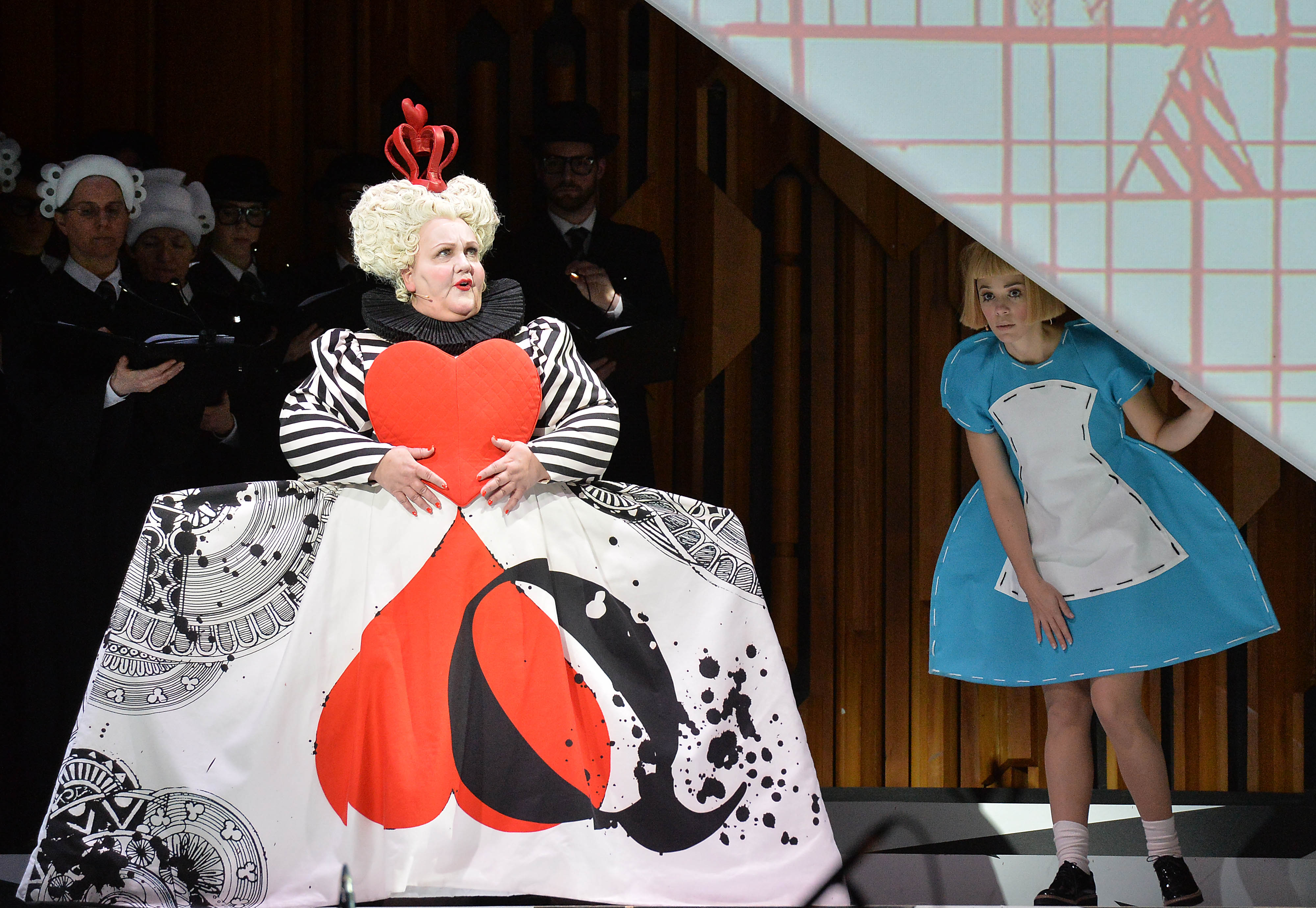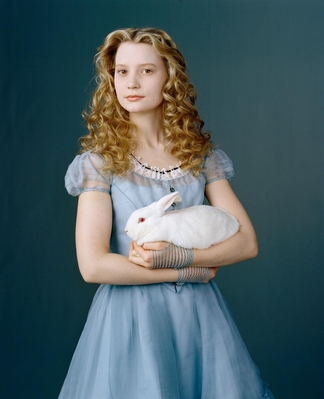Alice in Wonderland, BBCSO, Brönnimann, Barbican | reviews, news & interviews
Alice in Wonderland, BBCSO, Brönnimann, Barbican
Alice in Wonderland, BBCSO, Brönnimann, Barbican
A curious tale gets a riotous musical telling
The Southbank Centre’s Women of the World Festival may have been the largest cultural event marking International Women’s Day 2015, but it wasn’t the most ambitious. Over at the Barbican two women were responsible for a multimedia opera staging whose spectacle, level of detail and sheer force of personnel involved was staggering.
Premiered in 2007, Unsuk Chin’s Alice in Wonderland has already had more outings than most contemporary operas. You could attribute this to the endless appeal of Lewis Carroll’s story, but it also has an awful lot to do with Chin’s witty, sonically imaginative and disquieting score. For this new production, staged for brief runs in both Los Angeles and London, Chin’s music is paired with the meticulous creativity of British director-designer Netia Jones to create a multimedia spectacle that transforms the sombre interior of the Barbican Hall into a riot of colour and sensation.
Jones takes Ralph Steadman’s acid 1970s pen and ink illustrations of Alice as her touchstone
A giant screen, poised diagonally on one corner as though dropped from a great height, fills the back of the stage, propped up by a luckless red-suited flunky, while the floors are patterned in zany monochromes. Even the orchestral musicians themselves (placed centre stage) aren’t exempt from Jones’s touch, each sporting a number on the back of their tail coats. One crawls determinedly around on the floor as the audience enters. Searching for something? You learn quickly not to ask why, just to surrender to whatever unfolds.

Jones takes Ralph Steadman’s acid 1970s pen and ink illustrations of Alice as her touchstone, bringing many to life as animations, and taking others as inspiration for costumes (brilliantly fashioned by Jemima Penny) and characters. Colours are primary, designs are remixed, trippy versions of traditional styles, exaggerated and distorted for comic effect. The Queen of Hearts (the suitably stentorian Jane Henschel) sports a ruff wide enough to take out anyone in a two-metre radius, while the Duchess (Jenni Bank) bulges and balloons in a costume that makes a mockery of a woman’s curves. There’s little of the cosy storybook here; the Mad Hatter and his companions wear something that comes very close to a straitjacket, while croquet-mallet flamingos bleed copiously on contact with the hedgehog balls.

Chin might get away with this if the work were trimmed back. After an initial burst of novelty and invention things do drag, especially in the courtroom scene, and could usefully have been tightened for this revival while the orchestration (reduced here, to fit the space) was being altered. There’s also a disproportionate emphasis on high, almost electronic sonorities. A combination of vocal glissandi, coloratura sopranos and upper strings and woodwind find those same denatured musical vibrations we recognise from Ligeti, deploying them a little mercilessly. Even the double basses pluck so hard their notes become brightly snapping textures, or strike their strings col legno for another brittle, tinkling sound.
Though contending with some rather crude amplification which flattens all the voices out, the cast sell every bar. From the warm purity and agility of Gilmore’s delivery, to Bank’s maniacal, glittering Duchess and the wonderful boys of the Tiffin Choir, they give surreal without overworking it – a delicate balance, and one Jones herself also triumphs at. This trip down the musical rabbit-hole is not without its storm clouds, but its creative ingenuity and invention, visual and musical, still make the journey a vivid and an entertaining one.
ALICE'S ADVENTURES ON STAGE AND SCREEN
Alice, Scottish Ballet. It should be a capital crime to attempt an Alice ballet - off with their heads
Alice's Adventures in Wonderland, Royal Ballet. Even the best butter would not help this plot-less evening
Alice's Adventures Under Ground, Barbican. Gerald Barry's crazy velocity berserks both Alice books in rude style
 Alice in Wonderland. Tim Burton takes on the fantasy classic
Alice in Wonderland. Tim Burton takes on the fantasy classic
Alice Through the Looking Glass. Mia Wasikowska (pictured), Helena Bonham Carter and Johnny Depp back in inventive if unfaithful Carroll sequel
Jan Švankmajer's Alice. The great Czech animator's remarkable first full-length film
wonder.land, National Theatre. Damon Albarn’s Alice musical has fun graphics, but a banal and didactic storyline
rating
Explore topics
Share this article
The future of Arts Journalism
You can stop theartsdesk.com closing!
We urgently need financing to survive. Our fundraising drive has thus far raised £49,000 but we need to reach £100,000 or we will be forced to close. Please contribute here: https://gofund.me/c3f6033d
And if you can forward this information to anyone who might assist, we’d be grateful.

Subscribe to theartsdesk.com
Thank you for continuing to read our work on theartsdesk.com. For unlimited access to every article in its entirety, including our archive of more than 15,000 pieces, we're asking for £5 per month or £40 per year. We feel it's a very good deal, and hope you do too.
To take a subscription now simply click here.
And if you're looking for that extra gift for a friend or family member, why not treat them to a theartsdesk.com gift subscription?
more Opera
 Káťa Kabanová, Glyndebourne review - emotional concentration in a salle modulable
Janáček superbly done through or in spite of the symbolism
Káťa Kabanová, Glyndebourne review - emotional concentration in a salle modulable
Janáček superbly done through or in spite of the symbolism
 Buxton International Festival 2025 review - a lavish offering of smaller-scale work
Allison Cook stands out in a fascinating integrated double bill of Bernstein and Poulenc
Buxton International Festival 2025 review - a lavish offering of smaller-scale work
Allison Cook stands out in a fascinating integrated double bill of Bernstein and Poulenc
 Tosca, Clonter Opera review - beauty and integrity in miniature
Happy surprises and a convincing interpretation of Puccini for today
Tosca, Clonter Opera review - beauty and integrity in miniature
Happy surprises and a convincing interpretation of Puccini for today
 Hamlet, Buxton International Festival review - how to re-imagine re-imagined Shakespeare
Music comes first in very 19th century, very Romantic, very French operatic creation
Hamlet, Buxton International Festival review - how to re-imagine re-imagined Shakespeare
Music comes first in very 19th century, very Romantic, very French operatic creation
 Falstaff, Glyndebourne review - knockabout and nostalgia in postwar Windsor
A fat knight to remember, and snappy stagecraft, overcome some tedious waits
Falstaff, Glyndebourne review - knockabout and nostalgia in postwar Windsor
A fat knight to remember, and snappy stagecraft, overcome some tedious waits
 Salome, LSO, Pappano, Barbican review - a partnership in a million
Asmik Grigorian is vocal perfection in league with a great conductor and orchestra
Salome, LSO, Pappano, Barbican review - a partnership in a million
Asmik Grigorian is vocal perfection in league with a great conductor and orchestra
 Semele, Royal Opera review - unholy smoke
Style comes and goes in a justifiably dark treatment of Handelian myth
Semele, Royal Opera review - unholy smoke
Style comes and goes in a justifiably dark treatment of Handelian myth
 Le nozze di Figaro, Glyndebourne review - perceptive humanity in period setting
Mostly glorious cast, sharp ideas, fussy conducting
Le nozze di Figaro, Glyndebourne review - perceptive humanity in period setting
Mostly glorious cast, sharp ideas, fussy conducting
 Fidelio, Garsington Opera review - a battle of sunshine and shadows
Intimacy yields to spectacle as Beethoven's light of freedom triumphs
Fidelio, Garsington Opera review - a battle of sunshine and shadows
Intimacy yields to spectacle as Beethoven's light of freedom triumphs
 Dangerous Matter, RNCM, Manchester review - opera meets science in an 18th century tale
Big doses of history and didaction are injected into 50 minutes of music theatre
Dangerous Matter, RNCM, Manchester review - opera meets science in an 18th century tale
Big doses of history and didaction are injected into 50 minutes of music theatre
 Mazeppa, Grange Park Opera review - a gripping reassessment
Unbalanced drama with a powerful core, uninhibitedly staged
Mazeppa, Grange Park Opera review - a gripping reassessment
Unbalanced drama with a powerful core, uninhibitedly staged
 Saul, Glyndebourne review - playful, visually ravishing descent into darkness
Ten years after it first opened Barrie Kosky's production still packs a hefty punch
Saul, Glyndebourne review - playful, visually ravishing descent into darkness
Ten years after it first opened Barrie Kosky's production still packs a hefty punch

Add comment